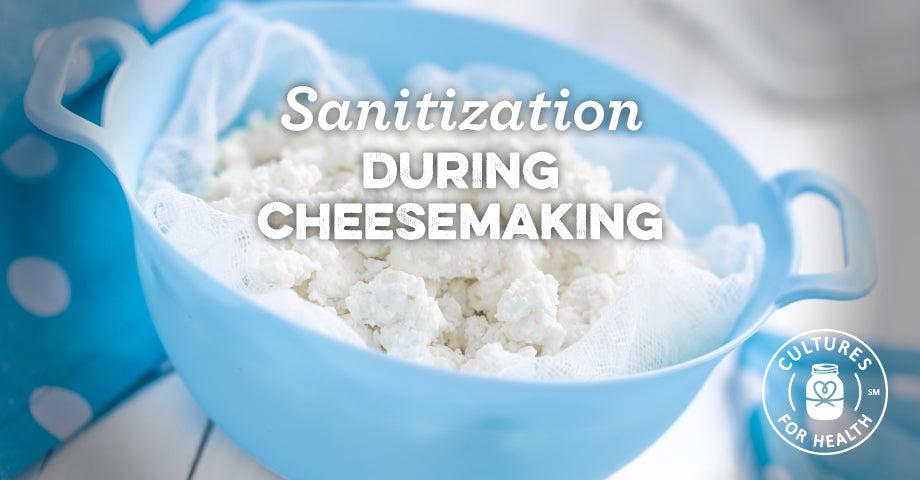
Making cheese relies largely on bacteria working to change and flavor the milk. But these bacteria must be the right kind of bacteria, from cheese cultures and fresh milk, not the bacteria found in or on unsanitary countertops, pots, bowls, or utensils. Causing a beneficial vs. harmful bacteria “war” in the milk introduces health risks and can cause the resulting cheese to be bland or underdeveloped, or just plain bad.
HOW ARE FOREIGN BACTERIA INTRODUCED IN CHEESEMAKING?
Most home cheesemaking failures can be attributed to one or more of the following:
- Poor milk-handling procedures
- Poor sanitizing of equipment
- Cross-contamination of the cheese with foreign bacteria at any stage during the process
While it may sound daunting, keeping your work area sanitized can greatly reduce the risk of contamination.
SANITIZING THE CHEESEMAKING WORK AREA
Follow these few simple steps to clean and sanitize your work area:
- Fill an atomizer with water and add about 1 capful of household bleach.
- Spray mixture onto countertops, stove, and sink, if using.
- Wait one full minute, then wipe surfaces clean using paper towels.
- Keep this spray and a roll of paper towels close by during the cheesemaking process, to wipe up spills or to re-wipe surfaces between steps.

Alternative to Sanitizing with Bleach
Bleach is by far the most efficient way to sanitize equipment. However, if using bleach is not an option, fill an atomizer with 1 cup of white vinegar, 3 cups of water and a few drops of lavender, tea tree, or peppermint essential oil.
SANITIZING METAL POTS AND UTENSILS
Metal utensils are easy to sterilize by boiling. Follow these simple steps:
- Wash pots and all utensils in very hot, soapy water.
- Rinse them in clear, cold water.
- Fill cheese pot about half full of clean water; put in all metal utensils.
- Put the pot on the stove and heat water to just boiling; turn off heat and cover.
STERILIZING NON-METAL UTENSILS
Anything else that needs to be sanitized but cannot be boiled, like plastic tools, can be sterilized as follows:
- Fill a 5-gallon bucket about ⅔ full of clean water. Add two capfuls of bleach. Soak non-metal utensils in the bucket for 10 minutes.
- Rinse utensils under clean running water quickly, because bleach residue may harm cultures or rennet during cheesemaking.
- Keep this bucket of bleach water on hand during the entire cheesemaking process. Use it for utensils you won’t be using for a longish period of time, remembering to rinse thoroughly before using again.
- Keep a large, clean towel spread out on the counter to place sanitized tools on until ready to use.
STERILIZING CHEESECLOTH AND BUTTER MUSLIN
To sterilize and clean cheesecloth and butter muslin for reuse, follow the instructions outlined in our article Cheesecloth and Butter Muslin.
6 TIPS FOR KEEPING A CLEAN WORK AREA FOR CHEESEMAKING
These tips will help you maintain a clean, sanitary work area and keep your cheese healthy and happy.
- Avoid wearing perfume, body spray, or scented lotions while making cheese, as they might cause an off flavor in the cheese.
- Keep pets out of the kitchen while making cheese.
- Keep countertop clutter to a minimum. Rinse tools as you use them, and wipe down surfaces as you work.
- Keep a few clean kitchen towels on hand for keeping hands dry and clean.
- Save other cooking tasks for later, after the cheesemaking is done.
- Wash your hands whenever you touch something not cheesemaking-related, to avoid adding any off flavor or harmful bacteria to the cheese.
By implementing a basic sanitization routine at the beginning of every cheese project and following simple rules during the cheesemaking process, you will be one step closer to assuring your ultimate success, resulting in a very tasty cheese.















